


Framed or unframed, desk size to sofa size, printed by us in Arizona and Alabama since 2007. Explore now.
Shorpy is funded by you. Patreon contributors get an ad-free experience.
Learn more.

- Baldwin 62303
- Baldwin VO-1000
- Cold
- No expense spared
- Tough Guys
- Lost in Toyland
- And without gloves
- If I were a blindfolded time traveler
- Smoke Consumer Also Cooks
- Oh that stove!
- Possibly still there?
- What?!?
- $100 Reward
- Freeze Frame
- Texas Flyer wanted
- Just a Year Too Soon
- WWII -- Replacing men with women at the railroad crossing.
- Yes, Icing
- You kids drive me nuts!
- NOT An Easy Job
- I wonder
- Just add window boxes
- Icing Platform?
- Indiana Harbor Belt abides
- Freezing haze
- Corrections (for those who care)
- C&NW at Nelson
- Fallen Flags
- A dangerous job made worse
- Water Stop
Print Emporium
Dr. Downing: 1901
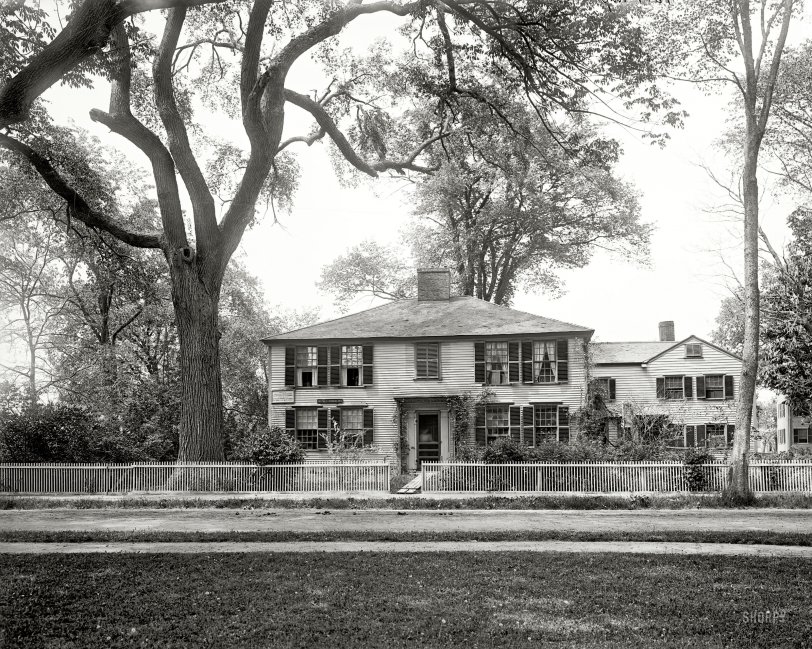
Lexington, Massachusetts, circa 1901. "Harrington House." The residence of one Dr. Bertha C. Downing. Detroit Publishing Co. glass negative. View full size.
Working shutters
One of the things I always appreciate seeing in period homes are the working shutters as opposed to the purely decorative features they have become today. Of course real shutters require some maintenance! Here the center window, second floor has the shutters closed. And there is a visible "shadow" that shows they are normally open.
Architorture
The house has lost more than its charming additions and center chimney. It has suffered more than the mere addition of a pretentious pediment.
The entrance has been widened; the pilasters themselves are replacements and farther apart than the originals (to accommodate more pretense in the form of surround moldings). This also allows room for an electric light fixture - yet another aesthetic/historic transgression. The original entablature was beautifully detailed; the existing one may as well have come from Home Depot. The pediment is ungainly and crowds the window above.
The importance of scale and integrity cannot be overstated when it comes to genuine preservation of historic structures. The Harrington House, with its
fake entry, disturbing downspout splitting the facade, dual chimneys, fenceless manicured lawn, brick walk and compositoon roof shingles has all the charm of 1970s suburban Colonial on a cul-de-sac in Northern Virginia.
Sadly, most "historic" or "restored" structures are similarly maimed. The house has lost its dignity and no longer conveys history as it actually was.
Regarding the stereoscopic photos of the house posted by
Born40YearsTooLate, the top photo is of a different house - look at the roof and window spacing on the second floor.
[If only you had been there to guide this poor house's multitude of benighted owners. - Dave]
Not So Stereo
The top picture posted by Born40YearsTooLate does not appear to be the Harrington house.
The roof line and pitch is does not match the subject house. The window above the door is too large as well as the spacing between the first and second floor windows is also too large. There is a side entrance to the right that is present in the top pic that is not duplicated in the other pics posted here. I would suspect the first pic was mislabeled.
[Houses then got remodeled to keep up with the latest architectural styles (Colonial to Federal to Greek Revival), just as they do today. Or were altered architecturally to suit their owners' tastes and needs, or to improve their functionality with advent of advances like indoor plumbing (bathrooms!) and electricity. It would not be unusual for an 18th-century house to have gone through several incarnations in its first 100 years, new roof and bigger windows included. I think it's certainly within the realm of possibility that the stereoview is correctly labeled. - Dave]
In regards to the large tree to the left of this house, that is quite an old tree already in 1901 and I would suspect its life span to be not much longer. Storms, age, pests and disease take their toll.
The photo below dated Oct. 19, 1929 shows the majestic tree to the left is now gone, but the tree to the right of the house is still intact, but with the obvious extra growth that 28 years will give.
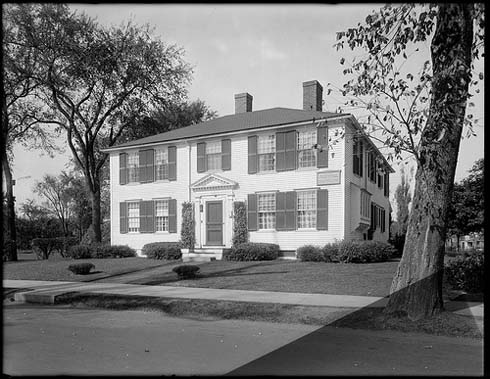
The Harringtons and the Battle of Lexington Green
I'm surprised no one commented on the Harrington connection, considering the fact that it involved the first battle of the Revolutionary War, Paul Revere's ride, and "The shot heard around the World"!
The rebels were on edge and had heard rumours of the British commander, General Gage's, intentions of sending a force out to put down the local militias and confiscate their arms. The famous "One if by land -- Two if by sea" was the alarm that sent William Dawes, Paul Revere, and a number of other riders out to warn of the British approach.
The ringing of the church bells, in the early hours of April 19th, 1775, brought 77 local men out onto Lexington Green. The British troops, led by Major Pitcairn, fired the first shots over the heads of the Patriots. When this did not have the desired effect of the making rebels lay down of their arms, Pitcairn ordered direct fire. A number of militiamen fell wounded or dead.
The Patriots, who had held their fire until fired upon, responded back. While they didn't appear to have actually hit the British, Pitcairn ordered his troops to withdraw to Concord for fear of being surrounded. The Revolutionary War had begun. John Harrington was one of the first men to fall in the war.
(For a full list of the names of the militiamen who were present and those wounded and killed: http://www.lexingtonhistory.org/pmwiki.php?n=Main.FrequentlyAskedQuestio... )
"Caleb Harrington, who had gone to the meeting-house for powder, was killed by a bullet as he came out, and Jonathan Harrington, Jr., was struck in front of his own house on the common. His wife was at the window. He fell, then got to his knees, and crawled to his doorstep. There he died as his wife reached him."
Postcard showing the memorial in the green across from the Harrington House http://www.cardcow.com/10333/jonathan-harrington-house-lexington-massach...
The green where the battle was fought.
Harringtons involved in the Battle of Lexington Green
John Harrington
Jonathan Harrington, Fifer
Jonathan Harrington, Jr. - Killed
Moses Harrington, 3rd
Moses Harrington, Jr.
Thaddeus Harrington
Thomas Harrington
And another different view http://www.cardcow.com/10203/home-of-jonathan-harrington-lexington-massa...
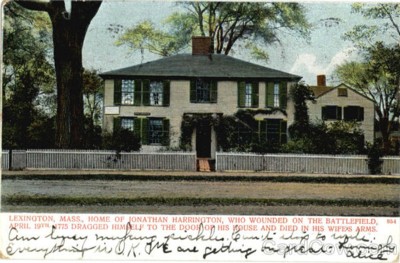
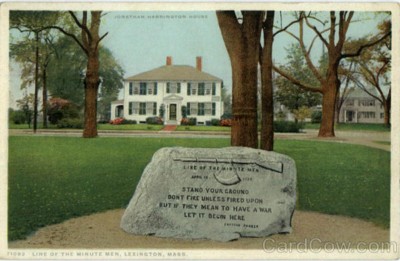
Tree Witness
It's too bad the huge tree was removed, it added an air of mystery to the property. It was probably witness to Jonathan Harrington's passing.
Preservation thoughts
The difficult thing to decide when preserving a structure is what "time" you want to adhere to. I think there are valid arguments to be made for preserving additions and "mistakes" to the structure, as they frequently reveal the more interesting history of the edifice. Of course, primary source documentation (photos, drawings, etc) helps with this. And there are cases where it would be desirable to "rebuild" or to "correct" a problem, especially when it's structural or a lasting defect.
But it is tricky to assume there is a pure state to a structure. There are powerful influences to portray history with a certain set of icons that aren't always valid. Much more truth is to be revealed by the iterations of a structure. In fact, it's what makes the historic structure, and many of the photos on Shorpy interesting to us in the first place. "Kalessin" was observant to notice the change in the chimneys. Another thing is the addition of the colonial detailing over the door. It could be that was never there, it was just added to make the place seem "colonial". There are always manifold interests when someone "preserves" a structure.
Screens are too there
They slide in just like the ones I use. And the good dr. is just as good a window-washer as me. And thank you for showing me that people could take good, ordinary photos like this.
[This picture is an 8x10 glass plate -- not quite an "ordinary photo," even in 1901. - Dave]
Dr. Bertha Downing
I'm almost certain that few women had achieved an M.D. degree in 1901. Can anyone tell me about Dr. Bertha Downing? I can't pick up anything on the Intertubes. Love, love the house.
[Try "Bertha C. Downing." Or read on below. - Dave]
Stereoscope pictures
The New York Public Library also has a couple of stereoscopic images of the Harrington House in its Robert N. Dennis collection (from the latter half of the nineteenth century).
One image shows two chimneys, along with a small addition.
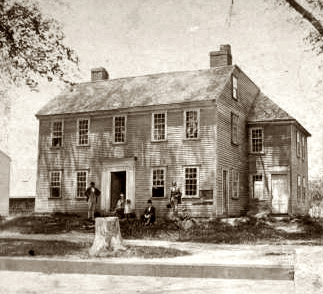
While the other shows the single central chimney of the 1901 photo, but with no addition.
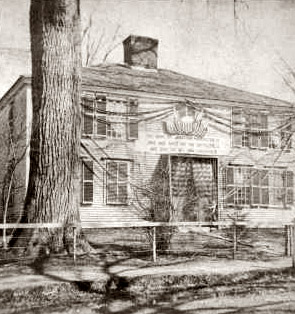
I like the older house...
...more than the newer one, which is sans addition. Now it looks like any other box that might well have been thrown up in time later 20th century. The sprawling appearance of older houses with add-ons that were themselves old, is part of the charm of an evolving home. Yes, houses get "re-muddled" but sometimes the extra rooms just add to the charm.
Home Improvement
This may be one of the few "today" photos that look better than the old ones.
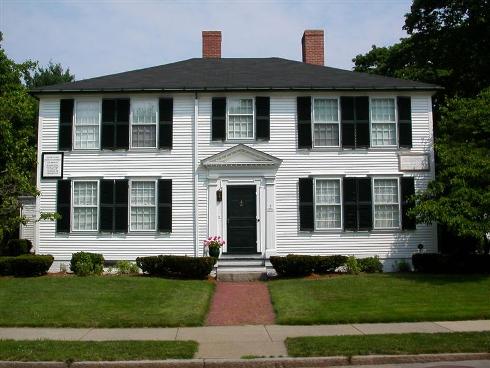
He is famous for
being wounded at the Battle of Lexington. He dragged himself to his house to die in the arms of his wife. I grew up in Lexington. For the annual reenactment one of my teachers played the wife.
My school was named after him, Harrington Elementary.
It was a different world then.
I noticed the plank walkway up to the front door and the lack of screens on the windows. The street out front is dirt (or mud) littered with horse droppings. We now take so many things for granted like paved roads and screens and air conditioning. These people were tougher than us.
A strangely familiar sight
How strange to see a house facade that's as familiar to me as any house I've lived in appearing on Shorpy! I grew up in Lexington, and spent lots of time on Lexington Green.
The house's appearance is mostly the same now as it was then. The two-story addition on the right rear of the main house is gone, and the "House of Jonathan Harrington" plaque has moved to the right end of the facade. Another plaque has been added at the left end for later owner John Augustus, a shoemaker who single-handedly created modern probation as an alternative to jail for petty crimes.
Lexington's Historical Commission is very strict about the external appearance and upkeep of the town's historic houses, all or nearly all of which are private residences (aside from the old tavern houses). If I remember correctly, it was modifications to this house and a threat of the destruction of nearby Buckman Tavern (where the minutemen gathered before the Battle of Lexington Green) that actually sparked Lexington's preservation movement.
This photo shows a big change to the house that I didn't know about (and which would never be allowed now), where it has one big central chimney in this picture, but now there are two smaller chimneys set to either side of where the old one was. This change implies some modifications to the interior, building up new chimney footings and probably replacing a big Colonial cooking hearth (think "walk-in fireplace") with a number of smaller fireplaces.
Bertha Caroline Downing, M.D.
Bertha Caroline Downing must have had some standing as a female doctor in that day and age. She seems to have specialized in "the feeble-minded."
She received her high school diploma from the Lyman school, in Boston (or at least in the Boston school board district) in 1869 (one of only three girls who graduated that year - 14 boys).
I am assuming that this is the same Dr. Bertha C. Downing who had fairly firm opinions about the number of "high-grade feeble-minded person who lands on our shore." She apparently was a doctor who was called upon to examine immigrants.
I studied medicine that I might know the feeble-minded child. As you know we have hundreds and thousands in our schools in the United States. Abnormal, nervous children who might be said to be two steps biologically back of the feeble-minded if given scientific care are savable. These make the parents of the feeble-minded and insane as Nordau shows.
I would ask the American Academy of Medicine to see if something cannot be done so that the high-grade feeble-minded individual as he lands on this shore may be recognized and sent back. We have the Binet-Simon tests
but do they tell the feeble-minded child? An X-ray picture of the hand reveals a condition diagnostic of all grades of feeble-minded children: a too early ossification of the wrist and hand bones; as the degree of ossification." (Bulletin Of The American Academy of Medicine VOLUME XIV, 1913)
She also had some opinions on the need for education of white children in the Southern Mountains.
I wrote some time ago to the Bureau of Education, Washington, D.C., to see if there was any money which they knew of that might be used for educating children of the whites of our Southern mountains. I was referred to the Page Bill and was told it could be turned to account and to get all my friends and every one whom I could influence to write their Congressman and get this Bill through. So I think it is "up to the Academy" to push that Bill, and save this most "fit" material to help offset the "unfit" we are hearing so much about — hundreds of thousands of children in these mountains with no means of even primary education, their heredity parallel with that of Lincoln.
She also wrote a book called "Defective Speech in Backward and Feeble-minded Children." However, her ideas on the care of the mentally ill were very enlightened.
A WORD FOR THE MENTAL INCOMPETENT.
Dr. Bertha C. Downing, in an interesting paper on the above subject in the Dietetic and Hygienic Gazette says: "Until nurses are trained in psychology so that they understand something of the personality of their patients and how illness changes this personality the camisole, the muff, and other like tortures found in our institutions (hospitals ?) for the insane, epileptic and feeble-minded, will not pass away. Neither will our patients in our general hospitals have the care they ought. With the knowledge we have today: constraint[?] should assist in the care of our mentally diseased ones. I recall a ward in a State institute for the insane where the attendant was a slight, small woman, whom nature endowed with a natural ability to deal with such people, who in 18 months never once had trouble with her charges. The big, burly men who are often placed over cases in the "violent ward" are always having trouble, and most of this trouble my own observation tells me is due to the attendant not understanding his charges."
An amusing side note, however, on the subject of women who choose to remain unmarried, from a newspaper article (Evening Post, Rōrahi LXXXIII, Putanga 50, 28 Huitanguru 1912, Page 9)"
Several months ago Mrs. Charlotte Smith of Boston, suggested a tax on bachelors but the Massachusetts Legislature did not see it quite that way and the suggestion was suppressed. Then came Dr. Bertha C. Downing, of Worcester, Mass, Calling for a tax on spinsters. Dr. Bertha Downing believes that women should wed, or pay a tax for the privilege of enjoying a life of single blessedness. She also blames the tendency to intellectuality among women for the lack of marriages. Her proposal, she declares, will make a girl hesitate before she decides to reject an eligible suitor for the sake of her books and independence. It will also prompt her to avail herself of the leap year privilege and do the proposing herself, in case the eligible young man is at all bashful."
Apparently, according to another article, she wanted the tax to extend to childless wives.
Given that she appears to have been an unmarried professional woman which higher education, this is a rather amusing opinion for her to hold.
----
I have since learned that she graduated from Clark University, in 1910.
Clark University Directory of Alumni, Faculty and Students.
FELLOWS, SCHOLARS AND STUDENTS
Downing, Bertha C 1905-1907; 1009-1914 Orr, C A. 1889-1800
Specialist in Orthogenics. 4 Downing St, Worcester, Mass.
Degree granted, Anthropology: Bertha Caroline Downing, June 16, 1910. A contribution to the scientific study of the hand.
If Only
Too bad Mr Harrington couldn't hang on for another 126 years. Dr. Downing might have saved him.
And here it is today
So which do Shorpyites prefer -- the 1901 building, with its non-1775 additions, or the more authentic mode, with its modern surroundings and lack of trees?
Ghosts and Apparitions
Is that the doctor's ghostly presence at the front door or a patient come back to haunt her?
The Doctor will see you now.
Jonathan (Jonathon) Harrington, Revolutionary War hero, meets Bertha Downing.

























On Shorpy:
Today’s Top 5